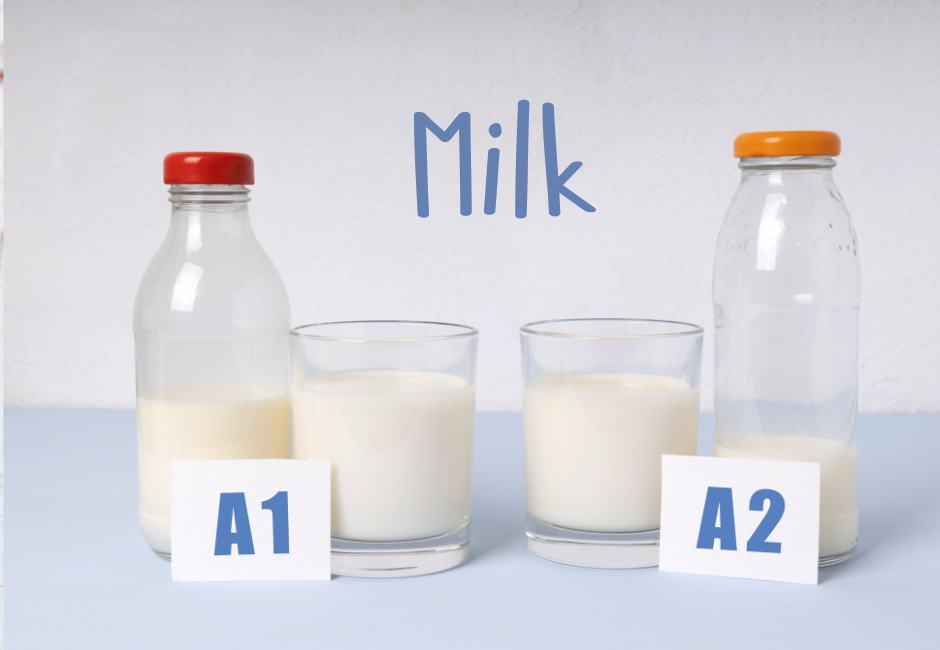
When it comes to choosing the right milk, you may have heard about A2 milk and its potential benefits. So, what exactly is A2 milk, is A2 milk good for babies? Let’s explore the benefits, how to introduce A2 milk, and some ideas for incorporating it into your baby’s diet.
What is A2 Milk?
A2 milk is a type of cow’s milk that contains only the A2 beta-casein protein, as opposed to regular milk, which typically contains both A1 and A2 proteins.
Some research suggests that A2 milk might be easier for babies to digest than regular milk, which could reduce some digestive issues like bloating or discomfort. If your baby has shown signs of milk sensitivity or tummy troubles with regular milk, A2 milk could be a gentler option.
Benefits of A2 Milk
- Easier to Digest
Some studies suggest that A2 milk may be easier for babies to digest than regular milk, which contains both A1 and A2 proteins. For babies who experience gas, bloating, or mild discomfort from traditional milk, A2 milk could help ease these issues.
- Potentially Reduced Risk of Discomfort
Since A2 milk contains only the A2 protein, it may reduce the chances of gastrointestinal issues in babies, such as cramps, bloating, or diarrhea that sometimes occur with A1 protein found in regular milk.
- Rich in Nutrients
A2 milk contains essential nutrients, including calcium, protein, and vitamins, that are important for your baby’s growth and development. It’s a natural source of these vital nutrients, helping your little one’s bones, muscles, and immune system develop properly.
- May Be Beneficial for Babies with Sensitivities
If your baby has a sensitivity or mild intolerance to milk, A2 milk could be a great alternative. Some parents report that their babies experience fewer digestive disturbances when consuming A2 milk.
A2 Milk vs. Regular Milk

One question I had when I first heard about A2 milk was: How does it compare to regular cow’s milk? Essentially, both A2 milk and regular milk offer similar nutritional benefits, including calcium, protein, and essential vitamins. However, the main difference lies in how the milk is processed by your baby’s digestive system.
Many parents who choose A2 milk report fewer digestive issues for their babies, but it’s important to remember that each baby’s needs are unique. A baby’s reaction to A2 milk may vary. So, what works for one baby may not work for another. It’s all about finding what best suits your little one’s needs.
How to Introduce A2 Milk into Your Baby’s Diet
Introducing A2 milk into your baby’s diet should be done gradually. It’s always a good idea to start by mixing a small amount of A2 milk with your baby’s regular milk or formula. Over the next few days, you can increase the A2 milk while decreasing the original milk, helping your baby adjust slowly to the new taste and texture.
It’s important to watch for any changes in your baby’s digestion as you make the switch. If you notice any discomfort or changes in bowel movements, consult your pediatrician.
Here are a few simple examples of meals to help you incorporate A2 milk into your baby’s diet:
- A2 Milk Oatmeal: Start your baby’s day with a creamy oatmeal by mixing A2 milk with oats.
- A2 Milk Smoothie: Blend A2 milk with fruits like mashed bananas or avocados to make a nutritious, tasty smoothie.
- A2 Milk Puree: Add A2 milk to homemade baby purees, such as sweet potatoes or carrots, to create a smoother consistency that’s easier to feed. If you’re looking for more ideas, check out 10 baby friendly avocado purees for delicious ways to incorporate milk into your baby’s meals.
By introducing A2 milk in small, manageable amounts and keeping track of your baby’s response, you can determine if it’s a good fit for your little one.
When to Consider A2 Milk For Your Baby
It’s important to consult with your pediatrician before making any changes to your baby’s diet. A2 milk might be especially beneficial for babies who have shown signs of milk sensitivity or discomfort from regular milk. However, A2 milk is not intended to replace breast milk or infant formula during the first year, as breast milk or formula is the most complete nutrition source for babies during this stage.
If your baby has digestive issues with regular milk, or if you suspect they may be sensitive to milk proteins, discussing A2 milk as a potential alternative with your healthcare provider could be helpful. For more information on common allergens and how to recognize them, check out my article on allergens to watch for in your baby’s diet.
By introducing A2 milk carefully and keeping a close eye on your baby’s response, you can help ensure a smooth transition. As always, it’s essential to listen to your pediatrician’s guidance to make sure you’re choosing the best option for your little one’s nutrition. Would you like to share your experience with A2 milk? Feel free to leave a comment below or share your thoughts!
Frequently Asked Questions (FAQ)
Q: Is A2 milk better than regular milk for my baby?
A2 milk may be easier to digest for babies who experience discomfort with regular milk. It contains only the A2 protein, which may reduce the chances of digestive upset, but it’s always best to consult your pediatrician before making any changes to your baby’s diet.
Q: Can I use A2 milk as a replacement for breast milk or formula?
No, A2 milk should not replace breast milk or formula in the first year. It can be a good option for babies who are transitioning from formula or breast milk after the first year, but it should not replace the essential nutrients provided by breast milk or infant formula.
Q: When should I introduce A2 milk to my baby?
A2 milk can be introduced when your baby begins transitioning to solids, typically after 6 months, and after consulting with your pediatrician. It’s essential to introduce any new type of milk gradually and monitor your baby’s reactions.
Q: Does A2 milk taste different from regular milk?
A2 milk tastes similar to regular milk, though some people find that it has a slightly creamier or smoother texture. Babies may not notice the difference if the switch is made gradually.
















Leave a Reply